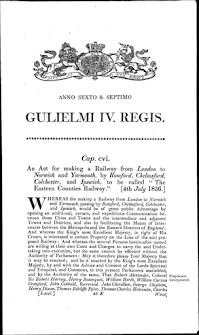One of the great battles in
the history of railway policing has been the pursuit of equality of pay and
conditions with territorial forces. Despite
the Wright Committee Report in 1979 (which led to pay parity) there is still no
statutory obligation on BTP to pay its officers the same as officers in other
forces. Indeed the allowances and
pension arrangements are still not as generous.
As recently as 2018 claims supported by the Superintendents’ Association
of England and Wales for back pay of allowances to ensure parity was rejected
by the Chief Constable and Police Authority.
I was then rather pleased to
read the Essex Standard of the 30 November 1838 which reported that the
Directors of the Eastern Counties Railway (the pre-cursor to the Great Eastern
Railway and then the LNER) had attended the Petty Sessions (Magistrates Court)
at Ilford to update the Bench on their plans for policing. The Justices were keen to know when police
would be introduced on the line and where they would be stationed. The Directors reported that the first
officers were ready to be sworn under the ‘new act’. This Act, the Eastern Counties Railways Act
1836, is an early example of legislation allowing the appointment of railway
police. In s241 the company was allowed
to nominate Special Constables to the Justices ‘for the preservation of the
peace and the security of persons and property’
Their powers to extend to 500 yards beyond the railway boundary. The Directors produced the first officers to
the court. The policy of the company was
that officers should have served in the forces and that ‘they were to be
selected solely for their merits and character…and to be of quiet demeanour’. The uniform consisted of ‘a blue coat and
trousers with yellow facings to the coat and a leather belt around the waist’. The new officers were sworn. The Chairman of the bench addressed them and
congratulated them upon their appointment.
He also enquired about pay and was told that the intention was that they
were to be paid at the same rate as the Metropolitan Police. The bench expressed their approbation at
these arrangements and told the new recruits that ‘they would also find the
bench ready to support them in any just cause they might bring before them’.
The railway itself didn’t
open until 1839 and we don’t know the identity of the new officers, or their
fate. Perhaps a little more research
will help fill in the gaps. In the
meantime it is good to see that equality of pay is nothing new for the railway
police.
Philip Trendall
February 2023
"ILFORD PETTY
SESSION." Essex Standard, 30 Nov. 1838. British Library Newspapers,
link.gale.com/apps/doc/R3208401105/BNCN?u=anglia_itw&sid=bookmark-BNCN&xid=c1b8a64f.
Accessed 9 Feb. 2023.

Comments
Post a Comment